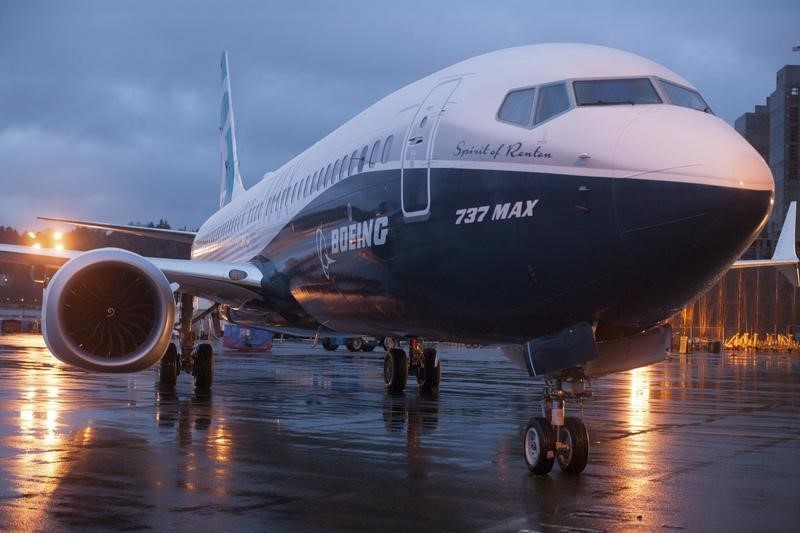Investing
Boeing boosts monthly 737 production as results beat estimates

© Reuters. FILE PHOTO: A photo of Boeing 737 MAX airplanes parked on the tarmac at the Boeing Factory in Renton, Washington, U.S. March 21, 2019. REUTERS/Lindsey Wasson/File Photo
By Valerie Insinna and Abhijith Ganapavaram
(Reuters) -Boeing is lifting production of its bestselling 737 narrow-body jet, but executives said Wednesday that it will take time for its facilities to stabilize production, even as they set their sights on future rate boosts.
Shares of the company rose 7% to hit a 1-1/2 year high after Boeing (NYSE:) also posted second-quarter results above Wall Street expectations.
The planemaker is now transitioning its 737 production line – including the MAX models that make up the vast majority of 737 production – to building 38 jets per month, up from 31, the company said.
“That’s a big important move, and there’ll be subsequent rate breaks beyond that,” said CEO Dave Calhoun. “All of that is going to play into a margin trajectory that’s going to start to look a lot more normal.”
Calhoun later added the company is already in “prep mode” to raise monthly 737 production to 42, but wouldn’t specify whether Boeing would do so in 2023, as Boeing Commercial Airplanes head Stan Deal said told Bloomberg TV in June.
The impacts of a 737 quality issue at supplier Spirit AeroSystems (NYSE:), a work stop at Spirit and recent collapse of a railway bridge used to transport 737 fuselages would be contained in the third quarter, but could delay “a few” airplane deliveries, Calhoun said.
Higher deliveries of the 787 Dreamliner helped spur a rise in revenue in its commercial planes division. However, Boeing Chief Financial Officer Brian West said commercial margins would show improvement but remain negative in the third-quarter.
‘ENCOURAGING’ RESULTS AMID CHALLENGES
“The overall outlook is unchanged, but the results from the Commercial Aerospace division is encouraging, particularly in light of the ongoing supply chain challenges,” Third Bridge analyst Peter McNally said.
“Boeing’s execution has improved, and it will need to continue on this path to turn the corner on sustained profitability.”
Margins at its defense business, however, were negative amid cost overruns. The company took a total of $514 million in charges related to the space capsule Starliner after its launch was indefinitely delayed in June, as well as for supply chain costs on the T-7 training jet and a schedule delay for the MQ-25 tanker drone.
“Our defense margins have got to get better next year, period, full stop,” West said.
The push to build 38 737s a month comes amid heightened travel demand as airlines seek to grow their fleets post-pandemic. Boeing expects to deliver most of the 228 MAXs in its inventory by the end of 2024, making it critical that Boeing step up production.
Of the inventory jets, 85 are for Chinese customers, and 55 MAXs were originally slated for Chinese airlines and have been remarketed, West said.
For the second quarter, Boeing reported free cash flow of $2.58 billion, compared with a cash burn of $182 million a year ago.
The adjusted loss was 82 cents per share. Analysts polled by Refinitiv were expecting a wider loss of 88 cents per share. Boeing’s revenue rose 18% to $19.75 billion, beating expectations of $18.45 billion.
Boeing reiterated its plan to generate $3 billion to $5 billion in free cash flow this year, as well as to deliver at least 400 single-aisle 737s and 70 787 Dreamliners in 2023.
Read the full article here

-

 Side Hustles5 days ago
Side Hustles5 days ago5 Things That Could Significantly Impact Your Company in 2025
-

 Investing5 days ago
Investing5 days agoNFI Group surge after board reshaped with new appointments, chairperson By Investing.com
-

 Side Hustles6 days ago
Side Hustles6 days agoHow Failing 22 Times Paved the Way to My Success
-

 Passive Income4 days ago
Passive Income4 days ago3 Challenges Entrepreneurs Will Face in 2025
-

 Side Hustles4 days ago
Side Hustles4 days agoThe Canadian Media Lawsuit That Could Reshape Tech’s Future
-

 Investing6 days ago
Investing6 days agoChinese hack of US telecoms compromised more firms than previously known, WSJ says By Reuters
-

 Investing6 days ago
Investing6 days agoApple Siri Settlement: Who Is Eligible for a Cash Payout
-

 Side Hustles6 days ago
Side Hustles6 days ago3 Strategies to Make Your Next Campaign Go Viral


















